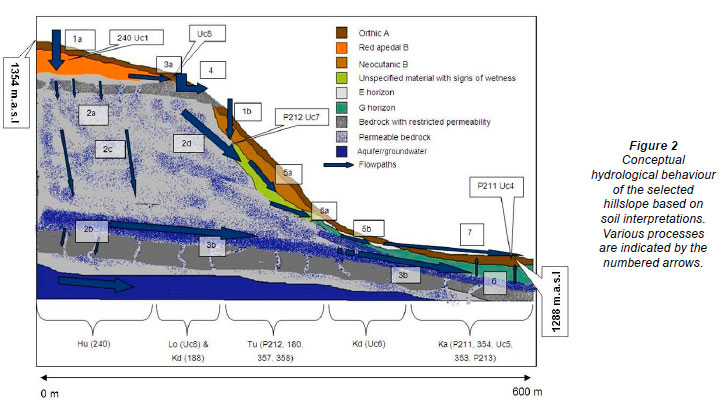

Similarly, positive relationships between plant Leaf Area Index ( L A I) or vegetation biomass 27, 30 and saturated soil hydraulic conductivity ( K s) have been observed, with stronger vegetation effects manifested in fine-textured soils compared to coarse soils 9, 30. Across a climatic gradient from xeric to hydric, the slope of the power-law relationship between above ground biomass and infiltration capacity decreased, with no discerned effects of soil texture on the relationship. A meta-analysis 26 has shown that the infiltration capacity in arid landscapes increases as a power-law function of above ground vegetation biomass, whereas the correlation was less significant in humid climates.

1i where the effective infiltration for different rainfall intensities (after accounting for canopy interception) varies with vegetation cover and affects runoff generation. In their seminal work, Dunne and co-authors 33 have shown strong positive feedbacks between the fraction of vegetation cover and average infiltration, as illustrated in Fig. It has been shown that the hydrological response of vegetated landscapes may vary significantly from non-vegetated areas in terms of runoff-infiltration partitioning under similar climatic conditions 14, 31, 32, 33, 34. To this end, a definition of functional relationships between landscape attributes and SHPs, in combination with appropriate regionalization functions and scaling operators 22, 24, might provide a way forward for a systematic and physically-based definition of SHPs across scales and locations 21, 23, 24, 25.įocusing primarily on biologically-enhanced soil structure, studies have shown consistent links between vegetation as a promoter of biological activity and soil structure, which, in turn, affects soil hydrological response and properties 26, 27, 28, 29, 30, 31. Effects of soil structure are expected to dominate the hydrological response in natural (non-arable) lands such as forested landscapes (≈30% of the Earth’s land surface 16) and in regions with intense rainfall rates.įurthermore, the standard parameterization of SHPs in LSMs uses sample scale information, often with little consideration of effective (scale informed) parameter values that account for the heterogeneity (in space and time) of natural landscapes and emergent hydrological nonlinearities and feedbacks 12, 17, 18, 19, 20, 21, 22, 23, 24. This sampling and measurement bias underrepresents the dominant role that soil structure (i.e., aggregation of soil particles, biopores formed by plant roots and earthworms) exerts on surface fluxes 1, 2, 9, 12, 13, 14, 15. In practice, PTFs are trained using measurements performed on laboratory-scale samples obtained from relatively uniform soils (i.e., agricultural fields) 11, 12. SHPs are generally derived from soil pedotransfer functions (PTFs) that correlate readily-available soil information (e.g., texture, bulk density, organic matter) with difficult-to-measure soil hydraulic parameters 6, 7, 8, 9, 10.

The proposed framework allows the incorporation of hydrological effects of soil structure with appropriate scale considerations into contemporary pedotransfer functions used for land surface parameterization.Įarth system and land surface models (LSMs) used for predictions of climatic and hydrological processes require spatially distributed soil hydraulic properties (SHPs) to represent surface fluxes, particularly the partitioning between infiltration and runoff 1, 2, 3, 4, 5. We demonstrate that small scale soil structure features prominently alter the hydrologic response emerging at larger scales and that upscaled parameterizations must consider spatial correlations between vegetation and soil texture. Here we propose a systematic framework to incorporate soil structure corrections into pedotransfer functions, informed by remote-sensing vegetation metrics and local soil texture, and use numerical simulations to investigate their effects on spatially distributed and areal averaged infiltration-runoff partitioning. However, current parameterizations rely on sample-scale information which often does not account for biologically-promoted soil structure and heterogeneities in natural landscapes, which may significantly alter infiltration-runoff and other exchange processes at larger scales. Earth system models use soil information to parameterize hard-to-measure soil hydraulic properties based on pedotransfer functions.


 0 kommentar(er)
0 kommentar(er)
